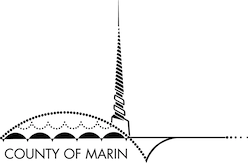Update from Kate - When It Rains, It Pours and Then Comes the Pollen!
County of Marin, California sent this bulletin at 05/25/2017 10:04 AM PDT
Update from Kate
When It Rains, It Pours And Then Comes the Pollen!
And What About Plants and Climate Change?
How Much Did It Rain This Year . . .
We all know it rained a lot this winter and sometimes seemed like the rain would never stop. But how much rain was there? On Tuesday, April 25, at our Board of Supervisors meeting, County flood control staff gave us some interesting numbers.
| Total rainfall accumulation from October 2016 to April 2017 |
Total rainfall accumulation for the prior period |
|
| Mill Valley | 47.24 inches | 29.98 inches |
| Kentfield | 82.66 inches | 38.18 inches |
| Novato | 46.65 inches | 22.42 inches |
| Pt. Reyes Station | 45.15 inches | 28.25 inches |
| Civic Center | 57.53 inches | 17.95 inches |
What a difference a year makes!
The rainstorms that brought all this water caused significant damage to both public and private property. The County is pursuing funding assistance from all available state and federal sources to assist with repair efforts for county-maintained levees, floodwalls, pumps, culverts and flood channels. We know local jurisdictions and homeowners are also hard at work to remedy storm damage. With sunshine and good weather we hope all of this work will get done so we will be ready for whatever next winter may bring.
Winter Showers Bring a Deluge of Spring Pollen and Allergy Misery
And with record rain, one can’t help but think about how this has affected the amount of pollen in ambient air. This spring, the dusting of pollen, covering everything, has made life and breathing miserable for scores of Marin residents and visitors.
Just as we measure rainfall, others count pollen (who knew!). The “pollen count” measures the grains of pollen per square meter of air collected over 24 hours at stations throughout the country. Pollen counts tend to be highest early in the morning on warm, breezy days and lowest during chilly, wet periods. The pollen forecast for Marin early in April was very high. Since then, pollen counts have taken a slightly downward trend with respect to tree pollens, most active this time of year.
If you are sensitive to pollen, either from trees, weeds or grasses, you may already visit sites like www.pollen.com to keep an eye on the pollen count from day to day to plan your activities. Some sites, like the Weather Channel, will send you pollen alerts via e-mail or text message. If you really want to dig in to the details, go to the pollen library to find out what’s blooming in your area.
And What About Plants and Climate Change?
Scientists at Point Blue Conservation Science, a local scientific research institute in West Marin, study pollen data as well as changes in plant communities in order to learn more about how changes in local and world climate may affect which plants can grow where – the spatial pattern of native plant communities. To protect biodiversity in the face of climate change, Point Blue emphasizes the importance of land conservation.
The landscape itself has a strong influence on local climate diversity and resilience. Plants and animals need large, well-connected areas of natural and working landscapes. Cool and moist locations can serve as “climate refugia,” and enhanced connectivity between protected areas can provide important migration pathways for plants and animals adapting to climate change. If you want to learn more about the science behind modeling climate impacts on vegetation, visit the Terrestrial Biodiversity Climate Change Collaborative (TBC3 – Climate Ready) here.
Are you seeing changes in plant communities here in Marin where you live? If you are, write me at ksears@marincounty.org and let me know what you’re seeing and share your thoughts.

